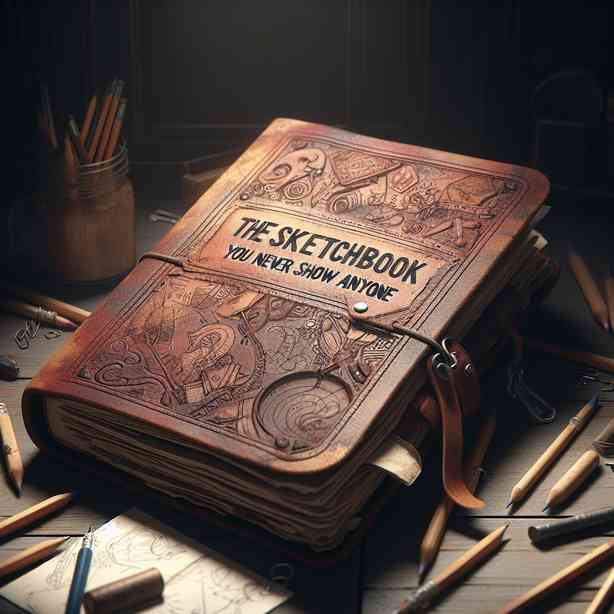
The Sketchbook You Never Show Anyone
There exists a unique space in our lives that often goes unspoken—the sketchbook you never show anyone. This sketchbook is a canvas of intimate thoughts, unfiltered creativity, and unrestrained expressions that reside within us. It is a sanctuary where raw emotions converge and ideas flourish without the fear of judgment. This blog post aims to explore the significance of such a personal sketchbook, its implications for our creative journeys, and the beauty of bringing forth hidden artistry into the world.
To begin with, the act of sketching itself is deeply personal. Each stroke of the pencil or brush captures fragments of who we are and how we perceive the world around us. The sketchbook becomes a reflection of our internal landscapes, representing our triumphs, struggles, aspirations, and sometimes, our vulnerabilities. While some may share their sketches widely, the book that remains closed is often richer in character and depth. It contains the unfinished pieces, the drafts that never made it to the final cut, or the sketches of ideas that haven’t yet taken form.
One may wonder why we hesitate to share these intimate creations. The reasons are often multifaceted. Fear of criticism is a common barrier, as we worry that our unrefined ideas will not resonate with others or, worse, lead to hurtful judgments. Likewise, there is the pressure to conform to societal standards of beauty and skill, compelling us to deem our own creations unworthy of visibility. This leads to a paradox: the very sketches that embody our truth, creativity, and authenticity are the ones we hesitate to reveal to the world.
Moreover, the sketchbook serves as a refuge for experimentation, where we can play with styles, colors, and concepts without the constraints typically imposed in the realm of public art. This freedom nurtures genuine creativity and fosters innovation. Artists often regard their sketchbooks as a testing ground—an exploratory phase where bizarre ideas can emerge without the fear of alienating audiences. There is an exhilarating notion in allowing oneself to be ‘bad’ at something, even temporarily, as it paves the way for growth and evolution.
As we delve deeper into the topic, it is essential to recognize how the sketchbook can serve as a valuable tool for personal development. For instance, maintaining a sketchbook can enhance mindfulness, encouraging us to carve out moments of stillness to recharge our mental batteries. The simple act of sketching can become a meditative practice, allowing us to process emotions and thoughts in a tangible form. This is particularly healing during challenging times, enabling the creation of visual dialogues rather than verbal ones, which may feel overwhelming.
Furthermore, exploring personal themes in our sketchbooks can unveil layers of self-discovery. By revisiting sketches, we may uncover patterns in our interests, styles, and emotional responses. This process can lead to profound insights about ourselves that we might otherwise overlook. In essence, a sketchbook can act as a diary, chronicling our artistic journey while unveiling our personal evolution throughout different phases of life.
The notion of the ‘sketchbook you never show anyone’ also prompts an exploration of vulnerability in art. Vulnerability has become a buzzword in recent years, often associated with authenticity and connection. By allowing ourselves to be vulnerable in our art, we may create more resonant pieces—ones that speak to shared human experiences. The tension between revealing and concealing our sketches becomes a central theme in artistic expression. Each time we choose not to share, we grapple with the question of whether a piece holds enough value to be seen by others.
Yet, there is a transformative potential in sharing our hidden sketches. When we bridge the gap between our private creations and the public sphere, we invite others into our worlds. This can lead to meaningful connections and discussions, as art often flourishes in community. Those who experience our work—be it in its raw, unfiltered form—may find comfort or inspiration in our process. They may recognize that their own struggles are mirrored in the very pieces we were too scared to expose.
In this light, the sketchbook becomes a vessel for connection, not just to oneself but also to others who may relate to the shared feelings and experiences captured within its pages. It offers a gentle reminder that art is not solely about perfection but rather sharing our imperfections and honoring our journeys. By showing those hidden pages, we may create a ripple effect of authenticity that encourages others to do the same.
However, the decision to unveil our sketchbooks can be daunting, and it’s crucial to approach this process with kindness to oneself. Art is not meant to be a competition, nor should it primarily serve as a metric of self-worth. Instead, it ought to be a source of enjoyment, healing, and expression. By embracing the fear of judgment and stepping into the light with our sketches, we can foster a sense of community that values openness, courage, and artistic exploration.
In conclusion, the sketchbook you never show anyone symbolizes the deeply personal journey we undertake as artists. It encourages self-reflection, experimentation, and vulnerability while navigating the complexities of creativity and self-expression. As we grapple with the decision to share these hidden parts of ourselves, may we ultimately embrace the beauty and imperfection of our creations. The world deserves to see the raw, unfiltered sketches that tell our stories and elevate our art beyond mere aesthetics, reminding us that we are all navigating a rich tapestry of experiences. Therefore, let us gather the courage to share that sketchbook, for within those pages lies not only our unspoken truths but also the potential to connect with others on the universal spectrum of human emotions.


